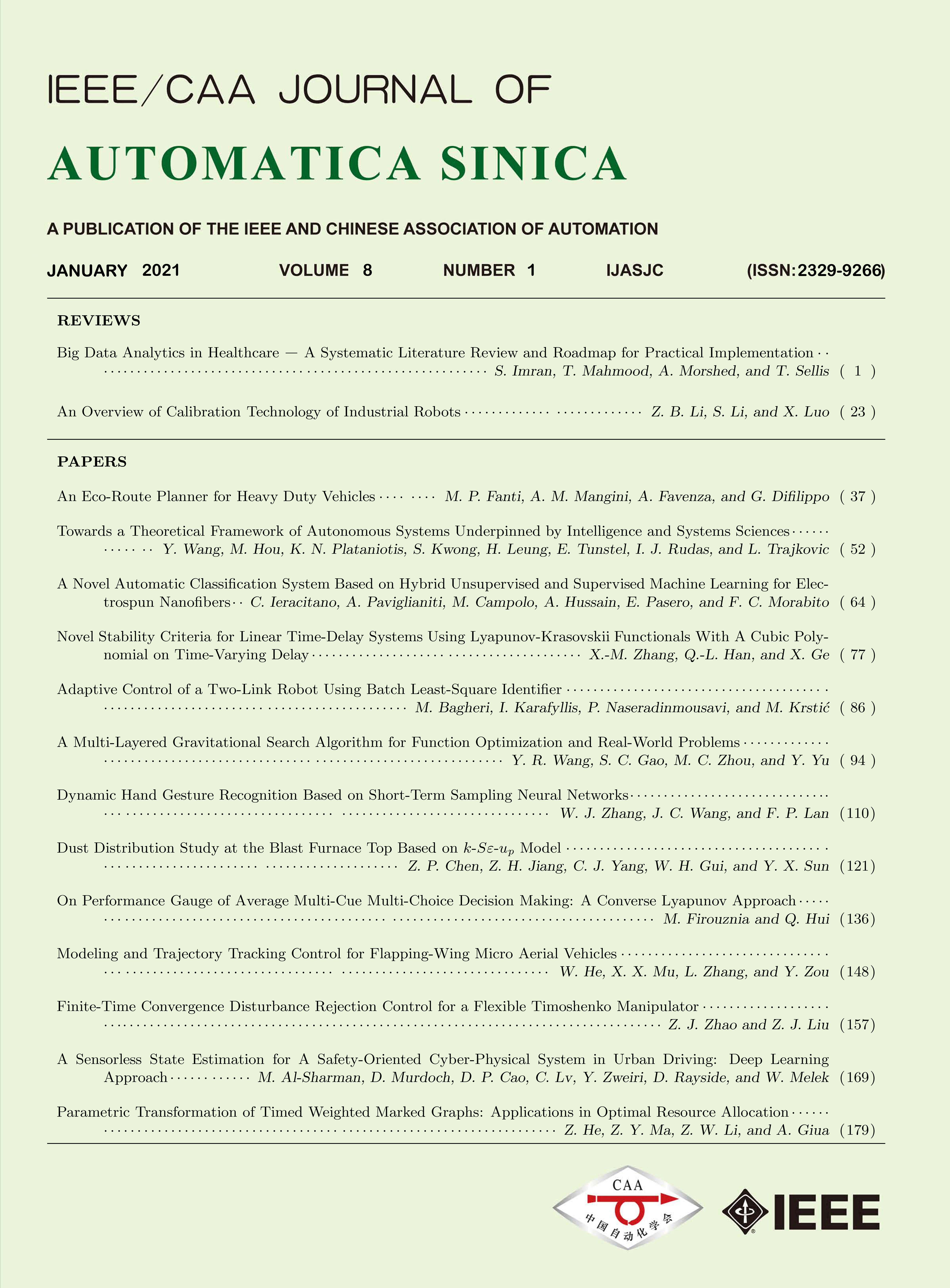 Volume 8
Issue 1
Volume 8
Issue 1
IEEE/CAA Journal of Automatica Sinica
| Citation: | Mostafa Bagheri, Iasson Karafyllis, Peiman Naseradinmousavi and Miroslav Krstić, "Adaptive Control of a Two-Link Robot Using Batch Least-Square Identifier," IEEE/CAA J. Autom. Sinica, vol. 8, no. 1, pp. 86-93, Jan. 2021. doi: 10.1109/JAS.2020.1003459 |

| [1] |
M. Bagheri, A. Ajoudani, J. Lee, D. G. Caldwell, and N. G. Tsagarakis, “Kinematic analysis and design considerations for optimal base frame arrangement of humanoid shoulders,” in Proc. IEEE Int. Conf. Robotics and Automation, 2015, pp. 2710–2715.
|
| [2] |
A. Bertino, M. Bagheri, P. Naseradinmousavi, and M. Krstić, “Experimental autonomous deep learning-based 3d path planning for a 7- dof robot manipulator,” in Proc. ASME Dynamic Systems and Control Conf., American Society of Mechanical Engineers, 2019.
|
| [3] |
M. Bagheri, M. Krstić, and P. Naseradinmousavi, “Joint-space trajectory optimization of a 7-dof baxter using multivariable extremum seeking,” in Proc. IEEE American Control Conf., Milwaukee, WI, 2018, pp. 2176–2181.
|
| [4] |
M. Bagheri, P. Naseradinmousavi, and M. Krstić, “Feedback linearization based predictor for time delay control of a high-dof robot manipulator,” Automatica, vol. 108, p. 108485, 2019.
|
| [5] |
J.-J. E. Slotine, W. Li et al., Applied Nonlinear Control. Prentice-Hall Englewood Cliffs, NJ, 1991, vol. 199, no. 1.
|
| [6] |
M. Krstić, I. Kanellakopoulos, and P. Kokotović, “Adaptive nonlinear control without overparametrization,” Systems &Control Letters, vol. 19, no. 3, pp. 177–185, 1992.
|
| [7] |
M. Krstić, I. Kanellakopoulos, and P. Kokotović, Nonlinear and Adaptive Control Design. Wiley-Interscience, 1995.
|
| [8] |
P. Naseradinmousavi, H. Ashrafiuon, and M. Bagheri, “A decentralized neuro-adaptive control scheme to suppress chaotic/hyperchaotic dynamics of smart valves network,” Journal of Computational and Nonlinear Dynamics, vol. 13, no. 5, Apr. 2018.
|
| [9] |
J.-J. Slotine and L. Weiping, “Adaptive manipulator control: A case study,” IEEE Transactions on Automatic Control, vol. 33, no. 11, pp. 995–1003, 1988. doi: 10.1109/9.14411
|
| [10] |
M. W. Spong, “On the robust control of robot manipulators,” IEEE Trans. Automatic Control, vol. 37, no. 11, pp. 1782–1786, 1992. doi: 10.1109/9.173151
|
| [11] |
H. Berghuis, R. Ortega, and H. Nijmeijer, “A robust adaptive robot controller,” IEEE Trans. Robotics and Automation, vol. 9, no. 6, pp. 825–830, 1993. doi: 10.1109/70.265925
|
| [12] |
C.-C. Cheah, C. Liu, and J.-J. E. Slotine, “Adaptive tracking control for robots with unknown kinematic and dynamic properties,” The Int. J. Robotics Research, vol. 25, no. 3, pp. 283–296, 2006. doi: 10.1177/0278364906063830
|
| [13] |
J.-J. E. Slotine and W. Li, “On the adaptive control of robot manipulators,” The International Journal of Robotics Research, vol. 6, no. 3, pp. 49–59, 1987. doi: 10.1177/027836498700600303
|
| [14] |
M. W. Spong, “Adaptive control of flexible joint manipulators,” Systems &Control Letters, vol. 13, no. 1, pp. 15–21, 1989.
|
| [15] |
R. Ortega and M. W. Spong, “Adaptive motion control of rigid robots: A tutorial,” Automatica, vol. 25, no. 6, pp. 877–888, 1989. doi: 10.1016/0005-1098(89)90054-X
|
| [16] |
M. W. Spong and R. Ortega, “On adaptive inverse dynamics control of rigid robots,” IEEE Trans. Automatic Control, vol. 35, no. 1, pp. 92–95, 1990. doi: 10.1109/9.45152
|
| [17] |
J.-J. E. Slotine and W. Li, “Composite adaptive control of robot manipulators,” Automatica, vol. 25, no. 4, pp. 509–519, 1989. doi: 10.1016/0005-1098(89)90094-0
|
| [18] |
W. Heemels, K. H. Johansson, and P. Tabuada, “An introduction to eventtriggered and self-triggered control,” in Proc. 51st IEEE IEEE Conf. on Decision and Control. IEEE, 2012, pp. 3270–3285.
|
| [19] |
I. Karafyllis and M. Krstić, “Adaptive certainty-equivalence control with regulation-triggered finite-time least-squares identification,” IEEE Trans. Automatic Control, vol. 63, no. 10, pp. 3261–3275, 2018. doi: 10.1109/TAC.2018.2798704
|
| [20] |
S. Sastry and M. Bodson, Adaptive Control: Stability, Convergence and Robustness. Courier Corporation, 2011.
|
| [21] |
P. A. Ioannou and J. Sun, Robust Adaptive Control. Courier Corporation, 2012.
|
| [22] |
I. Karafyllis, M. Kontorinaki, and M. Krstic, “Adaptive control by regulation-triggered batch least-squares,” IEEE Trans. Automatic Control, 2019.
|
| [23] |
M. Bagheri and P. Naseradinmousavi, “Novel analytical and experimental trajectory optimization of a 7-DOF baxter robot: global design sensitivity and step size analyses,” The Int. Journal of Advanced Manufacturing Technology, vol. 93, no. 9–12, pp. 4153–4167, Dec. 2017. doi: 10.1007/s00170-017-0877-x
|
| [24] |
M. Bagheri, P. Naseradinmousavi, and R. Morsi, “Experimental and novel analytical trajectory optimization of a 7-DOF baxter robot: Global design sensitivity and step size analyses,” in Proc. ASME Dynamic Systems and Control Conf., American Society of Mechanical Engineers. American Society of Mechanical Engineers, 2017, p. V001T30A001.
|
| [25] |
M. Bagheri, M. Krstić, and P. Naseradinmousavi, “Multivariable extremum seeking for joint-space trajectory optimization of a high-degreesof-freedom robot,” Journal of Dynamic Systems, Measurement, and Control, vol. 140, no. 11, p. 111017, 2018. DOI: 10.1115/1.4040752.
|